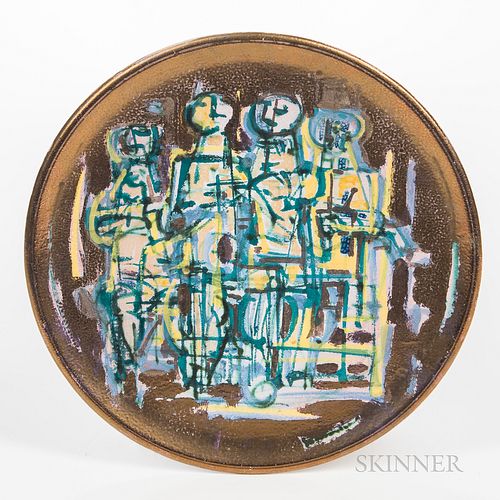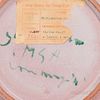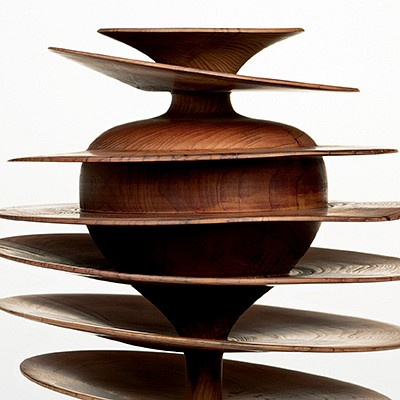Emilio Scanavino (Italian, 1922-1986) Ceramic Exhibition Plate, likely Albissola Marina, Italy, c. 1952, painted and gold lustre glazed
Lot 1336
About Seller
Bonhams Skinner
274 Cedar Hill Street
Marlborough, MA 01752
United States
Founded over four decades ago, Bonhams Skinner offers more than 60 auctions annually. Bonhams Skinner auctions reach an international audience and showcase the unique, rare, and beautiful in dozens of categories, including the fine and decorative arts, jewelry, modern design, musical instruments, sc...Read more
Categories
About Auction
Catalog Only
By Bonhams Skinner
Dec 8, 2020 - Dec 17, 2020
Set Reminder
2020-12-08 12:00:00
2020-12-17 19:00:00
America/New_York
Bidsquare
Bidsquare : 20th Century Design
https://www.bidsquare.com/auctions/skinner/20th-century-design-6191
Our December sale offers over 500 lots for the discerning collector, dealer, or homeowner seeking furniture, artwork, and decorative objects spanning the 20th and early 21st centuries. Bonhams Skinner bidsquare@bonhamsskinner.com
Our December sale offers over 500 lots for the discerning collector, dealer, or homeowner seeking furniture, artwork, and decorative objects spanning the 20th and early 21st centuries. Bonhams Skinner bidsquare@bonhamsskinner.com
- Lot Description
Emilio Scanavino (Italian, 1922-1986) Ceramic Exhibition Plate, likely Albissola Marina, Italy, c. 1952, painted and gold lustre glazed ceramic, signed l.r. "Scanavino" on front, painted signature "Scanavino," "MSA," and "illegible" on verso partially obscured by paper label which translated reads "1st National Exhibit of the Ceramic Arts," dia. 10 3/4 in.
Note: Emilio Scanavino was an Italian painter and sculptor. Scanavino was born in Genoa. In 1938 he enrolled to the Art School Nicolò Barabino where he met Mario Calonghi, who was teaching at the school and was due to be a great influence on Scanavino's artistic formation. In 1942 he had his first exhibition at the Salone Romano of Genoa. In the same year he enrolled at the Faculty of Architecture at the Milan University. In 1946 he married Giorgina Graglia.
In 1947 Scanavino moved to Paris where he met poets and artists such as Edouard Jaguer, Wols and Camille Bryen. This experience proved to be inspirational. He was especially interested in Cubism, which he rendered into a personal interpretation when he exhibited at the Gallery Isola in Genoa in 1948. In 1950 Scanavino and Rocco Borrella joined "I sette del Numero",[1] an artistic group revolving around the Numero Gallery in Florence. In the same year he was invited to the 27th edition of the Venice Biennale and in 1951 he had a two-person exhibition with the sculptor Sarah Jackson at the Apollinaire Gallery in London. During his time in London Scanavino met Philip Martin, Eduardo Paolozzi, Graham Sutherland and Francis Bacon. In the same year he opened his first studio in Milan in an attic in Foro Bonaparte. Critic Guido Ballo and dealers Guido Le Noci and Arturo Schwartz were early champions of his works.
In 1952, Scanavino worked at the Marzotti's Ceramic Factory in Albissola Marina, where he met and befriended many artists, including Lucio Fontana, Asger Jorn, Corneille, Roberto Matta, Wifredo Lam, Giuseppe Capogrossi, Enrico Baj, Sergio Dangelo, Roberto Crippa, Gianni Dova, Agenore Fabbri, and Aligi Sassu.
In 1954 he exhibited again at the Venice Biennale and in 1955 he received the Graziano Prize. In 1958 he won the Lissone Prize and the Prampolini Prize for a solo presentation at the Venice Biennale. In the same year he moved to Milan where he joined the Naviglio Gallery directed by Carlo Cardazzo with whom he established a long-standing friendship and working relationship.Condition
Any condition statement is given as a courtesy to a client, is only an opinion and should not be treated as a statement of fact. Skinner Inc. shall have no responsibility for any error or omission. The absence of a condition statement does not imply that the lot is in perfect condition or completely free from wear and tear, imperfections or the effects of aging. - Shipping Info
-
Please visit http://www.skinnerinc.com/services/payment-and-shipping/ for information regarding the collection of items purchased at auction.
-
- Buyer's Premium



 EUR
EUR CAD
CAD AUD
AUD GBP
GBP MXN
MXN HKD
HKD CNY
CNY MYR
MYR SEK
SEK SGD
SGD CHF
CHF THB
THB














